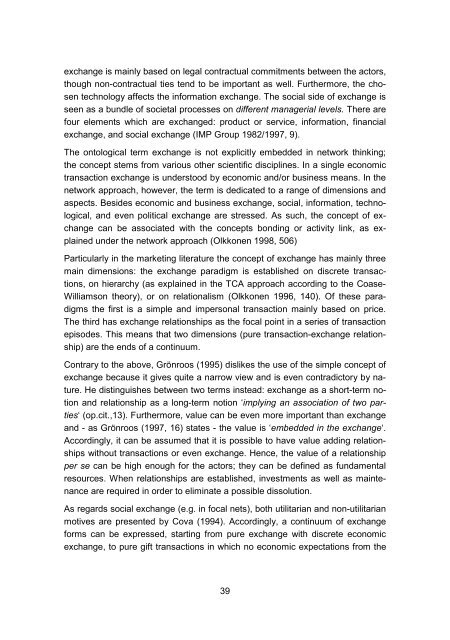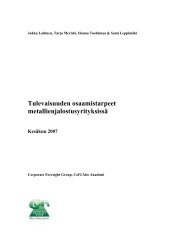849954 sisus
849954 sisus
849954 sisus
You also want an ePaper? Increase the reach of your titles
YUMPU automatically turns print PDFs into web optimized ePapers that Google loves.
exchange is mainly based on legal contractual commitments between the actors,<br />
though non-contractual ties tend to be important as well. Furthermore, the chosen<br />
technology affects the information exchange. The social side of exchange is<br />
seen as a bundle of societal processes on different managerial levels. There are<br />
four elements which are exchanged: product or service, information, financial<br />
exchange, and social exchange (IMP Group 1982/1997, 9).<br />
The ontological term exchange is not explicitly embedded in network thinking;<br />
the concept stems from various other scientific disciplines. In a single economic<br />
transaction exchange is understood by economic and/or business means. In the<br />
network approach, however, the term is dedicated to a range of dimensions and<br />
aspects. Besides economic and business exchange, social, information, technological,<br />
and even political exchange are stressed. As such, the concept of exchange<br />
can be associated with the concepts bonding or activity link, as explained<br />
under the network approach (Olkkonen 1998, 506)<br />
Particularly in the marketing literature the concept of exchange has mainly three<br />
main dimensions: the exchange paradigm is established on discrete transactions,<br />
on hierarchy (as explained in the TCA approach according to the Coase-<br />
Williamson theory), or on relationalism (Olkkonen 1996, 140). Of these paradigms<br />
the first is a simple and impersonal transaction mainly based on price.<br />
The third has exchange relationships as the focal point in a series of transaction<br />
episodes. This means that two dimensions (pure transaction-exchange relationship)<br />
are the ends of a continuum.<br />
Contrary to the above, Grönroos (1995) dislikes the use of the simple concept of<br />
exchange because it gives quite a narrow view and is even contradictory by nature.<br />
He distinguishes between two terms instead: exchange as a short-term notion<br />
and relationship as a long-term notion ‘implying an association of two parties‘<br />
(op.cit.,13). Furthermore, value can be even more important than exchange<br />
and - as Grönroos (1997, 16) states - the value is ‘embedded in the exchange‘.<br />
Accordingly, it can be assumed that it is possible to have value adding relationships<br />
without transactions or even exchange. Hence, the value of a relationship<br />
per se can be high enough for the actors; they can be defined as fundamental<br />
resources. When relationships are established, investments as well as maintenance<br />
are required in order to eliminate a possible dissolution.<br />
As regards social exchange (e.g. in focal nets), both utilitarian and non-utilitarian<br />
motives are presented by Cova (1994). Accordingly, a continuum of exchange<br />
forms can be expressed, starting from pure exchange with discrete economic<br />
exchange, to pure gift transactions in which no economic expectations from the<br />
39








